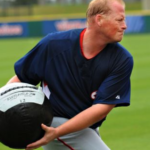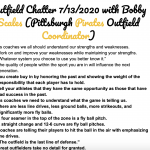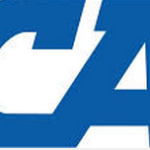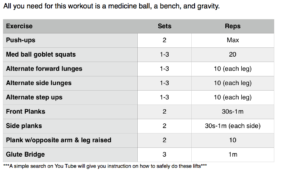I’m still stronger, I still win
There is no sport where being weaker benefits you. When given the choice between being stronger than your opponent or being weaker than your opponent, every athlete would choose to be stronger than their opponent.
Unfortunately, a large portion of the baseball community hasn’t quite caught on to this idea yet. Although, if you are still reading this article, you are probably grateful that there are many coaches out there who haven’t yet bought into strength and conditioning, because it gives you a competitive edge.
 My strength and conditioning program has been overhauled several times in the last 15 seasons, but up until two years ago, it was lacking one MAJOR component, an in season plan.
My strength and conditioning program has been overhauled several times in the last 15 seasons, but up until two years ago, it was lacking one MAJOR component, an in season plan.
Why you and your players should buy into in season strength and conditioning
I finally got to the point where my players were working incredibly hard in the weight room in the offseason. They were seeing huge gains and it was starting to show on the field. But unknowingly, all of this hard work had essentially disappeared by the time the most important time of the season arrived.
Just 2-4 weeks after finishing a weight training program, athletes will begin to lose sport specific strength, and overall strength. By the time our playoffs arrived at the end of May, many of my players hasn’t lifted a weight in 12-16 weeks. All that hard work in the offseason was no longer with them when it mattered most, and if they play summer ball, they could go through their competitive season of 24-30 weeks without being in a weight room.
If we just maintain our strength during the season, by week 4 of our season, we have a competitive edge over those who do not lift during the season. By week 16, that gap will be even larger. So, just by maintaining any strength gains you made in the offseason, you will be gaining on anyone who doesn’t lift in season.
What you should do in your in season strength and conditioning program
First, understand that if you neglected strength and conditioning in the offseason, it probably isn’t the best idea to hop into a weight room and start trying to gain strength. In the section below, I will discuss what to do in that situation, or with younger players.
The four main goals of an in season conditioning program should be to maintain strength, speed, and mobility, and to stay healthy. There may be some strength gains during the season, but the main goal should just be to maintain.
Two years ago, we began building strength and conditioning time into our practices twice per week. We lift at the end of practice at least two days apart. If we have a heavy week of games, we may only lift once per week.
There will be little need to train the baseball specific movements such as medicine ball side throws and rotational explosive work. If they are swinging and throwing every day at close to 100% effort, that will most likely be good enough to maintain rotational power. We put medicine ball side tosses in our warm-ups to get some heavy work on that movement, but we don’t specifically put any time into it in the weight room during the season.
In order to maintain strength, players need to lift heavy weights. This flies in the face of a lot of conventional wisdom that coaches have used in the past. The theory of lifting light weight for high reps that has been popular in the past simply will not maintain strength. If you wanted to maintain your Calculus skills, you wouldn’t just do Algebra I.
The same theory applies in the weight room. If you want to maintain your strength, you need to lift heavy things in the weight room. So the question becomes, how do you do that safely in season? The key is to keep sets and reps (volume) low while keeping weight high.
The Cornerstone Elite Membership Contains BOTH In and Offseason Strength and Conditioning Programs
I do realize that baseball coaches are not necessarily strength coaches (although at most high schools, you have a dual role), so the idea of a %1RM (Percent of one rep max) may be a bit foreign. As a rule of thumb, 60% 1RM should be a weight that a player could lift approximately 12 times to failure, 75%-80% would be a weight the could lift approximately 5-6 times to failure.
Doing this, or a similar program 1-2 times per week will help your players maintain their strength and actually gain on anyone who isn’t strength training during the season.
What if we didn’t strength train this offseason?
If your players, or son, did not strength train this offseason, or if they are too young for strength training in a weight room, it would not be wise for them to start a weight raining program during the season. They will be very, very sore, probably won’t be able to fit often enough to see any significant strength gains, and may be at an increased risk of injury.
That is not to say they shouldn’t condition during the season. You still want them to maintain whatever strength they have during the season. This “at the field” conditioning workout can be done a few times per week for 15-20 minutes and will help players maintain their strength throughout the season.
Nutrition’s role
In addition to your players maintaining their strength this offseason, they will also need to maintain their weight. It is not uncommon for many players to lose weight throughout the season due with muscle loss and not eating enough food.
It is not uncommon for players to go long periods of time without eating during the season. For example, if a player has lunch at 11:00 during the school day, and brings nothing else to eat, it could be 5-6pm before he eats again on practice days. If it is a game day, it could be 7-8pm before he eats again. That’s a period of 8-9 hours!!
Player’s should monitor their weight every week and adjust their eating schedule and food intake accordingly. If they notice they are losing weight, they will need to increase their caloric intake and make sure to bring pre-game and post game food to refuel. Something high in protein, that is not too greasy, and is low in processed sugar would be ideal, but the main goal will be to get the player to stop dropping weight during the season.
Summary
If you want to ensure your athletes are performing their best at the end of the season, they will need to be sure they are reasonably close to the same strength and weight they were at the beginning of the season.
To do this, you will need to work some weight room time in to your practice time roughly one or two times per week with the focus being lifting heavier weights and keeping volume (sets and reps) low. This will maintain strength and minimize soreness and injury.
By simply maintaining your strength and weight to the end of the year, your players will be at an advantage over every team that stayed out of the weight room all season.
For more great information
If you are a high school coach, travel coach, or parent of a player check out our free Coaching Library here:
Join our FREE coaching library
More from my site
 Effective Communication with Parents Part I: Establishing the Groundwork
Effective Communication with Parents Part I: Establishing the Groundwork CCA Podcast 225 – Zach Casto – Part 2 – Outfield play and analytics
CCA Podcast 225 – Zach Casto – Part 2 – Outfield play and analytics CCA Podcast 193 – Jump starting your offseason conditioning program
CCA Podcast 193 – Jump starting your offseason conditioning program CCA 031: Nailing your assistant coach interview
CCA 031: Nailing your assistant coach interview 2013 Clinic Summary
2013 Clinic Summary CCA Podcast Episode 001: Playing College Baseball
CCA Podcast Episode 001: Playing College Baseball
 Posted by Kyle Nelson
Posted by Kyle Nelson- Posted in Conditioning
 Mar, 19, 2017
Mar, 19, 2017 No Comments.
No Comments.
Elite members login here
Check out what’s New/Hot!
Recognizing, Diagnosing, and Fixing Common Hitting Flaws eCourse The 3 metrics we tested on Blast motion sensors this year Sneak Peek Inside an Elite Q and A The batting practice continuum Elite Member’s area table of contents 50+ “Chaos” hitting drills
5 sample Chaos hitting drills FREE
Mental Skills and Culture Building The hitting pyramid Welcome Elite Member, Trey! Ideas for a pitcher first practice 12 week bat speed improvement plan Make plans this offseason to have your team playing their best baseball at the end of the year” Top 5 hitting drills to translate practice skill to game performanceHow we used Blast Motion sensors with a team in 2019
What to do if your hitters are overmatched Welcome Elite Member, Tommy! Setting your baserunners up for success Welcome Elite Member, Mike! A consulting call with Elite Member Matt FREE Web Clinic: Developing Athletic, Consistent, Extraordinary Infielders
 Coach Kyle Nelson
Coach Kyle Nelson